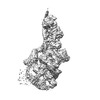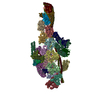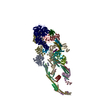+ Open data
Open data
- Basic information
Basic information
| Entry | Database: EMDB / ID: EMD-2860 | |||||||||
|---|---|---|---|---|---|---|---|---|---|---|
| Title | Electron cryo-microscopy of dynein/dynactin/GFP-BICD2N complex | |||||||||
 Map data Map data | Reconstruction of dynein tail/dynactin/GFP-BICD2N complex. | |||||||||
 Sample Sample |
| |||||||||
 Keywords Keywords | dynein / dynactin / BICD2 / motor / transport | |||||||||
| Function / homology |  Function and homology information Function and homology informationCOPI-independent Golgi-to-ER retrograde traffic / RHOD GTPase cycle / Factors involved in megakaryocyte development and platelet production / retrograde axonal transport of mitochondrion / Gap junction degradation / Formation of annular gap junctions / Regulation of actin dynamics for phagocytic cup formation / EPHB-mediated forward signaling / Adherens junctions interactions / VEGFA-VEGFR2 Pathway ...COPI-independent Golgi-to-ER retrograde traffic / RHOD GTPase cycle / Factors involved in megakaryocyte development and platelet production / retrograde axonal transport of mitochondrion / Gap junction degradation / Formation of annular gap junctions / Regulation of actin dynamics for phagocytic cup formation / EPHB-mediated forward signaling / Adherens junctions interactions / VEGFA-VEGFR2 Pathway / Cell-extracellular matrix interactions / RHO GTPases Activate WASPs and WAVEs / MAP2K and MAPK activation / UCH proteinases / Clathrin-mediated endocytosis / RHOF GTPase cycle / dynactin complex / Regulation of PLK1 Activity at G2/M Transition / Loss of Nlp from mitotic centrosomes / Recruitment of mitotic centrosome proteins and complexes / Loss of proteins required for interphase microtubule organization from the centrosome / Anchoring of the basal body to the plasma membrane / AURKA Activation by TPX2 / transport along microtubule / visual behavior / WASH complex / F-actin capping protein complex / positive regulation of intracellular transport / dynein light chain binding / negative regulation of filopodium assembly / regulation of metaphase plate congression / dynein heavy chain binding / establishment of spindle localization / axonemal dynein complex / positive regulation of spindle assembly / ciliary tip / structural constituent of postsynaptic actin cytoskeleton / dense body / Intraflagellar transport / dynein complex / Neutrophil degranulation / COPI-independent Golgi-to-ER retrograde traffic / P-body assembly / coronary vasculature development / minus-end-directed microtubule motor activity / barbed-end actin filament capping / dynein light intermediate chain binding / cytoplasmic dynein complex / regulation of cell morphogenesis / retrograde axonal transport / RHO GTPases activate IQGAPs / regulation of lamellipodium assembly / RHO GTPases Activate Formins / aorta development / nuclear migration / Recruitment of NuMA to mitotic centrosomes / HSP90 chaperone cycle for steroid hormone receptors (SHR) in the presence of ligand / MHC class II antigen presentation / COPI-mediated anterograde transport / ventricular septum development / centrosome localization / microtubule motor activity / dynein intermediate chain binding / dynein complex binding / NuA4 histone acetyltransferase complex / microtubule-based movement / cytoplasmic microtubule / Amplification of signal from unattached kinetochores via a MAD2 inhibitory signal / COPI-mediated anterograde transport / stress granule assembly / stress fiber / Mitotic Prometaphase / cytoplasmic microtubule organization / EML4 and NUDC in mitotic spindle formation / regulation of mitotic spindle organization / Loss of Nlp from mitotic centrosomes / Loss of proteins required for interphase microtubule organization from the centrosome / axon cytoplasm / Recruitment of mitotic centrosome proteins and complexes / cytoskeleton organization / Recruitment of NuMA to mitotic centrosomes / Resolution of Sister Chromatid Cohesion / Anchoring of the basal body to the plasma membrane / HSP90 chaperone cycle for steroid hormone receptors (SHR) in the presence of ligand / MHC class II antigen presentation / sarcomere / AURKA Activation by TPX2 / axonogenesis / cellular response to nerve growth factor stimulus / mitotic spindle organization / filopodium / RHO GTPases Activate Formins / cell motility / actin filament / Hydrolases; Acting on acid anhydrides; Acting on acid anhydrides to facilitate cellular and subcellular movement / cell morphogenesis / kinetochore / cilium / Aggrephagy / microtubule cytoskeleton organization Similarity search - Function | |||||||||
| Biological species |  Homo sapiens (human) / Homo sapiens (human) /   | |||||||||
| Method | single particle reconstruction / cryo EM / Resolution: 8.2 Å | |||||||||
 Authors Authors | Urnavicius L / Zhang K / Diamant AG / Motz C / Schlager MA / Yu M / Patel NA / Robinson CV / Carter AP | |||||||||
 Citation Citation |  Journal: Science / Year: 2015 Journal: Science / Year: 2015Title: The structure of the dynactin complex and its interaction with dynein. Authors: Linas Urnavicius / Kai Zhang / Aristides G Diamant / Carina Motz / Max A Schlager / Minmin Yu / Nisha A Patel / Carol V Robinson / Andrew P Carter /  Abstract: Dynactin is an essential cofactor for the microtubule motor cytoplasmic dynein-1. We report the structure of the 23-subunit dynactin complex by cryo-electron microscopy to 4.0 angstroms. Our ...Dynactin is an essential cofactor for the microtubule motor cytoplasmic dynein-1. We report the structure of the 23-subunit dynactin complex by cryo-electron microscopy to 4.0 angstroms. Our reconstruction reveals how dynactin is built around a filament containing eight copies of the actin-related protein Arp1 and one of β-actin. The filament is capped at each end by distinct protein complexes, and its length is defined by elongated peptides that emerge from the α-helical shoulder domain. A further 8.2 angstrom structure of the complex between dynein, dynactin, and the motility-inducing cargo adaptor Bicaudal-D2 shows how the translational symmetry of the dynein tail matches that of the dynactin filament. The Bicaudal-D2 coiled coil runs between dynein and dynactin to stabilize the mutually dependent interactions between all three components. | |||||||||
| History |
|
- Structure visualization
Structure visualization
| Movie |
 Movie viewer Movie viewer |
|---|---|
| Structure viewer | EM map:  SurfView SurfView Molmil Molmil Jmol/JSmol Jmol/JSmol |
| Supplemental images |
- Downloads & links
Downloads & links
-EMDB archive
| Map data |  emd_2860.map.gz emd_2860.map.gz | 10.9 MB |  EMDB map data format EMDB map data format | |
|---|---|---|---|---|
| Header (meta data) |  emd-2860-v30.xml emd-2860-v30.xml emd-2860.xml emd-2860.xml | 10.8 KB 10.8 KB | Display Display |  EMDB header EMDB header |
| Images |  emd_2860.png emd_2860.png | 2.2 MB | ||
| Archive directory |  http://ftp.pdbj.org/pub/emdb/structures/EMD-2860 http://ftp.pdbj.org/pub/emdb/structures/EMD-2860 ftp://ftp.pdbj.org/pub/emdb/structures/EMD-2860 ftp://ftp.pdbj.org/pub/emdb/structures/EMD-2860 | HTTPS FTP |
-Validation report
| Summary document |  emd_2860_validation.pdf.gz emd_2860_validation.pdf.gz | 200.8 KB | Display |  EMDB validaton report EMDB validaton report |
|---|---|---|---|---|
| Full document |  emd_2860_full_validation.pdf.gz emd_2860_full_validation.pdf.gz | 199.9 KB | Display | |
| Data in XML |  emd_2860_validation.xml.gz emd_2860_validation.xml.gz | 7.3 KB | Display | |
| Arichive directory |  https://ftp.pdbj.org/pub/emdb/validation_reports/EMD-2860 https://ftp.pdbj.org/pub/emdb/validation_reports/EMD-2860 ftp://ftp.pdbj.org/pub/emdb/validation_reports/EMD-2860 ftp://ftp.pdbj.org/pub/emdb/validation_reports/EMD-2860 | HTTPS FTP |
-Related structure data
| Related structure data |  5afuMC  6f3aM  6zo4M  2854C  2855C  2856C  2857C  2861C  2862C  5adxC  5afrC M: atomic model generated by this map C: citing same article ( |
|---|---|
| Similar structure data |
- Links
Links
| EMDB pages |  EMDB (EBI/PDBe) / EMDB (EBI/PDBe) /  EMDataResource EMDataResource |
|---|---|
| Related items in Molecule of the Month |
- Map
Map
| File |  Download / File: emd_2860.map.gz / Format: CCP4 / Size: 300.3 MB / Type: IMAGE STORED AS FLOATING POINT NUMBER (4 BYTES) Download / File: emd_2860.map.gz / Format: CCP4 / Size: 300.3 MB / Type: IMAGE STORED AS FLOATING POINT NUMBER (4 BYTES) | ||||||||||||||||||||||||||||||||||||||||||||||||||||||||||||
|---|---|---|---|---|---|---|---|---|---|---|---|---|---|---|---|---|---|---|---|---|---|---|---|---|---|---|---|---|---|---|---|---|---|---|---|---|---|---|---|---|---|---|---|---|---|---|---|---|---|---|---|---|---|---|---|---|---|---|---|---|---|
| Annotation | Reconstruction of dynein tail/dynactin/GFP-BICD2N complex. | ||||||||||||||||||||||||||||||||||||||||||||||||||||||||||||
| Voxel size | X=Y=Z: 1.34 Å | ||||||||||||||||||||||||||||||||||||||||||||||||||||||||||||
| Density |
| ||||||||||||||||||||||||||||||||||||||||||||||||||||||||||||
| Symmetry | Space group: 1 | ||||||||||||||||||||||||||||||||||||||||||||||||||||||||||||
| Details | EMDB XML:
CCP4 map header:
| ||||||||||||||||||||||||||||||||||||||||||||||||||||||||||||
-Supplemental data
- Sample components
Sample components
-Entire : Cryo-EM structure of dynein tail/dynactin/GFP-BICD2N
| Entire | Name: Cryo-EM structure of dynein tail/dynactin/GFP-BICD2N |
|---|---|
| Components |
|
-Supramolecule #1000: Cryo-EM structure of dynein tail/dynactin/GFP-BICD2N
| Supramolecule | Name: Cryo-EM structure of dynein tail/dynactin/GFP-BICD2N / type: sample / ID: 1000 / Details: The sample was monodisperse / Number unique components: 3 |
|---|---|
| Molecular weight | Theoretical: 2.6 MDa |
-Macromolecule #1: Human cytoplasmic dynein 1 tail
| Macromolecule | Name: Human cytoplasmic dynein 1 tail / type: protein_or_peptide / ID: 1 / Name.synonym: TDB / Number of copies: 1 / Recombinant expression: No |
|---|---|
| Source (natural) | Organism:  Homo sapiens (human) / synonym: Human//Mouse / Location in cell: cytoplasm Homo sapiens (human) / synonym: Human//Mouse / Location in cell: cytoplasm |
| Molecular weight | Theoretical: 2.6 MDa |
-Macromolecule #2: mouse BICD2N
| Macromolecule | Name: mouse BICD2N / type: protein_or_peptide / ID: 2 / Number of copies: 1 / Recombinant expression: No |
|---|---|
| Source (natural) | Organism:  |
-Macromolecule #3: pig dynactin
| Macromolecule | Name: pig dynactin / type: protein_or_peptide / ID: 3 / Number of copies: 1 / Recombinant expression: No |
|---|---|
| Source (natural) | Organism:  |
-Experimental details
-Structure determination
| Method | cryo EM |
|---|---|
 Processing Processing | single particle reconstruction |
| Aggregation state | particle |
- Sample preparation
Sample preparation
| Concentration | 0.075 mg/mL |
|---|---|
| Buffer | pH: 7.4 Details: 150mM KCl, 25mM HEPES-KOH, 1mM MgCl2, 0.1mM MgATP, 5mM DTT |
| Grid | Details: Quantifoil R1.2/1.3 400 mesh copper grid with thin carbon support, glow discharged |
| Vitrification | Cryogen name: ETHANE / Chamber humidity: 100 % / Chamber temperature: 120 K / Instrument: FEI VITROBOT MARK III / Method: Blot for 3.5 seconds before plunging |
- Electron microscopy
Electron microscopy
| Microscope | FEI TITAN KRIOS |
|---|---|
| Temperature | Average: 100 K |
| Alignment procedure | Legacy - Astigmatism: Objective lens astigmatism was corrected at 120,000 times magnification. |
| Date | Jul 17, 2014 |
| Image recording | Category: CCD / Film or detector model: FEI FALCON II (4k x 4k) / Number real images: 4259 / Average electron dose: 1 e/Å2 / Bits/pixel: 16 |
| Electron beam | Acceleration voltage: 300 kV / Electron source:  FIELD EMISSION GUN FIELD EMISSION GUN |
| Electron optics | Calibrated magnification: 82353 / Illumination mode: FLOOD BEAM / Imaging mode: BRIGHT FIELD / Cs: 2.7 mm / Nominal defocus max: 8.0 µm / Nominal defocus min: 3.0 µm / Nominal magnification: 47000 |
| Sample stage | Specimen holder model: FEI TITAN KRIOS AUTOGRID HOLDER |
| Experimental equipment |  Model: Titan Krios / Image courtesy: FEI Company |
- Image processing
Image processing
| Details | The particles were selected using an automatic selection program. |
|---|---|
| CTF correction | Details: Each particle |
| Final reconstruction | Applied symmetry - Point group: C1 (asymmetric) / Algorithm: OTHER / Resolution.type: BY AUTHOR / Resolution: 8.2 Å / Resolution method: OTHER / Software - Name: Relion / Number images used: 85744 |
 Movie
Movie Controller
Controller

































